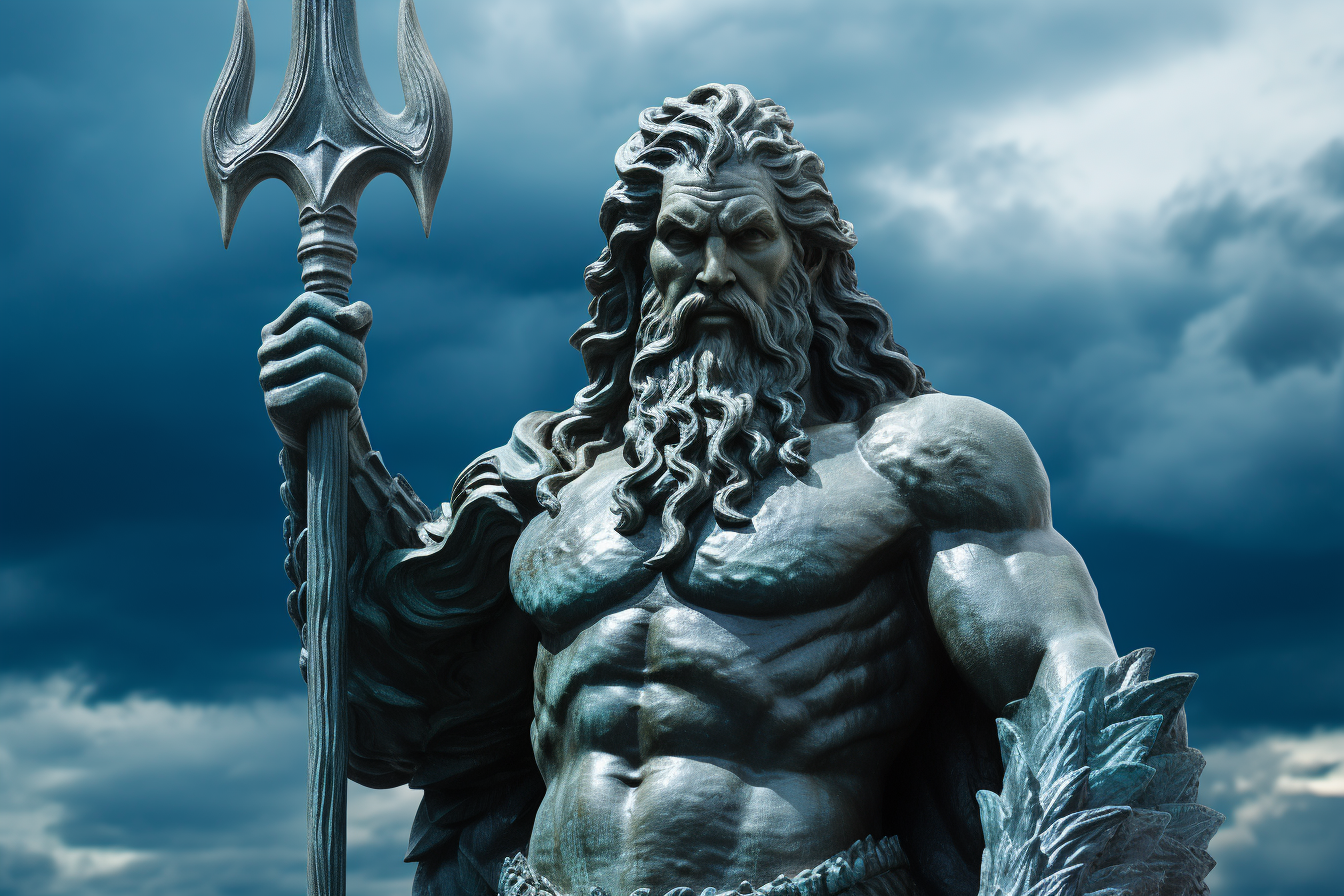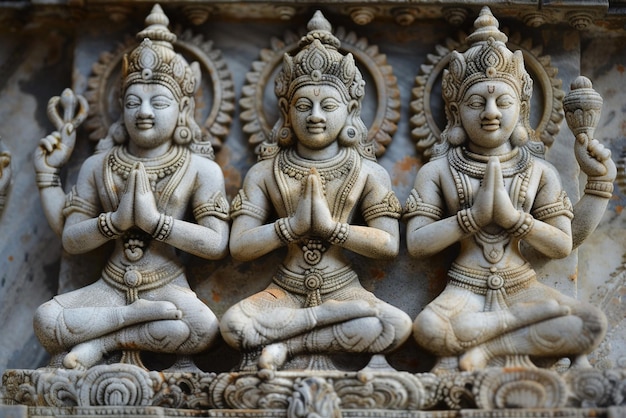DarkPagan666
Active member
The trident, a three-pronged spear, carries rich symbolism across religious, spiritual, and occult traditions. Its meanings vary depending on the cultural context, but they generally revolve around themes of power, authority, spiritual forces, and duality. The trident symbolizes the mastery over the elements. It represents the unification of these forces and the balance between them, often symbolizing a link between the material and spiritual worlds.

In various spiritual traditions, the number three has a sacred significance, representing a triad or triple aspect of divinity. The trident, with its three prongs, can symbolize this triadic nature, such as body, mind, and spirit; past, present, and future; or birth, life, and death. It represents a perfect number, the trine force, Ea – Enlil – Anu, Poseidon – Zeus – Hades, the trinity of the worlds.
In occult traditions, the trident can be viewed as a symbol of power and dominion, particularly over spiritual forces or energies. Its shape evokes a sense of both creation and destruction, reflecting dual aspects of any force - positive and negative, life-giving and death-dealing.
In alchemical symbolism, the trident represents the three principles (sulfur, mercury, and salt) that form the basis of alchemical transformation. It reflects the synthesis and interaction of these fundamental elements to achieve spiritual and material transformation. Sulfur symbolizes the principle of combustion and represents the spirit or soul. In alchemical thought, sulfur corresponds to volatility, passion, and transformation, as well as fire. Mercury known as the principle of liquidity, mercury (or quicksilver) represents the mind or the element of consciousness. It corresponds to fluidity, changeability, and adaptability and is associated with air and water. Salt is seen as the principle of solidity and preservation. It represents the body or physical matter and is associated with crystallization, stability, and earth.

The fleur-de-lis is another example of the Trident, and has strong correlations to Neptune, as it is of a purely spiritual connotation. It symbolizes the idea of spiritual enlightenment and rebirth. Its association with the lily, a flower known for blooming beautifully in muddy waters, embodies the concept of spiritual awakening and purity emerging from impurity or struggle.
The upward-pointing petals signify the soul's journey towards spiritual ascension and the overcoming of earthly limitations. It represents the transcendence of the material world to reach a higher spiritual state.
Moreover, it represents the process of transformation and the attainment of spiritual knowledge. It is sometimes associated with the three stages of alchemical work: Nigredo (blackening), Albedo (whitening), and Rubedo (reddening), which reflects the purification and perfection of matter and spirit.

As most of you know, the trident is famously associated with Poseidon (Greek) and Neptune (Roman), the gods of the sea. It represents their dominion over water, the power to create storms, calm the sea, and even cause earthquakes (Poseidon was known as the "Earth-Shaker"). In this context, the trident symbolizes the elemental power of water and the dual nature of the sea - both nurturing and destructive. Neptune's trident is a force of nature, representing water, power, and transformation, which aligns with spiritual purification.
In some esoteric traditions, the fleur-de-lis is seen as a protective symbol, warding off negative influences or evil spirits. It has been used as talismans and charms for this very purpose, as it functions as a mark of authority and a magical seal.

In Hindu mythology, the trident (known as Trishula) is a powerful symbol associated with the god Shiva, who wields it as a weapon to destroy evil and ignorance. The three prongs are often interpreted as representing the three aspects of existence: creation, preservation, and destruction, which align with the Trimurti (Brahma, Vishnu, and Shiva). It also symbolizes the three gunas (fundamental qualities of nature): sattva (purity), rajas (activity), and tamas (darkness).
Phanes is a deity from the Orphic tradition of ancient Greek religion, specifically the Orphic Cosmogony. Phanes is a primordial being who represents the creation of the cosmos and is often referred to as "the firstborn" or "the protoparent." He is said to have emerged from the cosmic egg, representing light, creation, and the divine force of life, the primary cause.
Similarly, in Ancient Greek tradition (Orphic Cosmogony), Eros is not just a god of romantic love but also a primordial force. This Eros is one of the first deities, representing the creative force of the universe that emerged at the beginning of time. In this sense, he is considered one of the first principles, a cosmic force of creation and union, the five elements, rather than a personal god of love.
Again, in Orphic cosmogony, Khronos is often depicted as the primal, serpentine force from which Phanes emerges. Time is seen as cyclical, bringing things into existence and eventually leading them to their end. This aligns with Shiva’s role in Hinduism, where he presides over cycles of creation and destruction - a natural end that makes room for new beginnings.
Khronos, therefore, represents ‘time’ itself in the Orphic tradition. While he is not strictly a destroyer, ‘time’ in Orphic thought has a transformative and inevitable force, causing all things to decay, transform, and ultimately pass away. With other words, Kronos represent eternal birth and death, the space between life and death, sequential, chronological and the inevitable.
Phanes (Primordial Being of Creation) aligns with Brahma (the Creator). Eros (Primordial Force of Love and Union) aligns with Vishnu (the Preserver). Khronos (Primordial Personification of Time) aligns with Shiva (the Destroyer).
Finally, we can look into the principles of Satan’s name, which full name is Satanas. If we interpret Satanas as representing a universal cycle, birth, existence, and return - then Satanas symbolically aligns with the same cosmic principles, each encompassing creation, preservation, and dissolution.
SA – representing the Birth, TAN – representing the Middle State of Existence, and AS – represents the eternal return. These are part of Satan's cosmic principles, the Trimurti, and represents Satan.
Hail Satan!
Sources:
1. https://en.wikipedia.org/wiki/Trident
2. https://en.wikipedia.org/wiki/Alchemical_symbol
3. https://www.britannica.com/topic/Neptune-Roman-god
4. https://www.britannica.com/topic/trimurti-Hinduism
5. https://www.hellenicgods.org/orphiccosmogonyandtheogony
6. https://joyofsatan.org/SATANAS.html

In various spiritual traditions, the number three has a sacred significance, representing a triad or triple aspect of divinity. The trident, with its three prongs, can symbolize this triadic nature, such as body, mind, and spirit; past, present, and future; or birth, life, and death. It represents a perfect number, the trine force, Ea – Enlil – Anu, Poseidon – Zeus – Hades, the trinity of the worlds.
In occult traditions, the trident can be viewed as a symbol of power and dominion, particularly over spiritual forces or energies. Its shape evokes a sense of both creation and destruction, reflecting dual aspects of any force - positive and negative, life-giving and death-dealing.
In alchemical symbolism, the trident represents the three principles (sulfur, mercury, and salt) that form the basis of alchemical transformation. It reflects the synthesis and interaction of these fundamental elements to achieve spiritual and material transformation. Sulfur symbolizes the principle of combustion and represents the spirit or soul. In alchemical thought, sulfur corresponds to volatility, passion, and transformation, as well as fire. Mercury known as the principle of liquidity, mercury (or quicksilver) represents the mind or the element of consciousness. It corresponds to fluidity, changeability, and adaptability and is associated with air and water. Salt is seen as the principle of solidity and preservation. It represents the body or physical matter and is associated with crystallization, stability, and earth.

The fleur-de-lis is another example of the Trident, and has strong correlations to Neptune, as it is of a purely spiritual connotation. It symbolizes the idea of spiritual enlightenment and rebirth. Its association with the lily, a flower known for blooming beautifully in muddy waters, embodies the concept of spiritual awakening and purity emerging from impurity or struggle.
The upward-pointing petals signify the soul's journey towards spiritual ascension and the overcoming of earthly limitations. It represents the transcendence of the material world to reach a higher spiritual state.
Moreover, it represents the process of transformation and the attainment of spiritual knowledge. It is sometimes associated with the three stages of alchemical work: Nigredo (blackening), Albedo (whitening), and Rubedo (reddening), which reflects the purification and perfection of matter and spirit.

As most of you know, the trident is famously associated with Poseidon (Greek) and Neptune (Roman), the gods of the sea. It represents their dominion over water, the power to create storms, calm the sea, and even cause earthquakes (Poseidon was known as the "Earth-Shaker"). In this context, the trident symbolizes the elemental power of water and the dual nature of the sea - both nurturing and destructive. Neptune's trident is a force of nature, representing water, power, and transformation, which aligns with spiritual purification.
In some esoteric traditions, the fleur-de-lis is seen as a protective symbol, warding off negative influences or evil spirits. It has been used as talismans and charms for this very purpose, as it functions as a mark of authority and a magical seal.

In Hindu mythology, the trident (known as Trishula) is a powerful symbol associated with the god Shiva, who wields it as a weapon to destroy evil and ignorance. The three prongs are often interpreted as representing the three aspects of existence: creation, preservation, and destruction, which align with the Trimurti (Brahma, Vishnu, and Shiva). It also symbolizes the three gunas (fundamental qualities of nature): sattva (purity), rajas (activity), and tamas (darkness).
Phanes is a deity from the Orphic tradition of ancient Greek religion, specifically the Orphic Cosmogony. Phanes is a primordial being who represents the creation of the cosmos and is often referred to as "the firstborn" or "the protoparent." He is said to have emerged from the cosmic egg, representing light, creation, and the divine force of life, the primary cause.
Similarly, in Ancient Greek tradition (Orphic Cosmogony), Eros is not just a god of romantic love but also a primordial force. This Eros is one of the first deities, representing the creative force of the universe that emerged at the beginning of time. In this sense, he is considered one of the first principles, a cosmic force of creation and union, the five elements, rather than a personal god of love.
Again, in Orphic cosmogony, Khronos is often depicted as the primal, serpentine force from which Phanes emerges. Time is seen as cyclical, bringing things into existence and eventually leading them to their end. This aligns with Shiva’s role in Hinduism, where he presides over cycles of creation and destruction - a natural end that makes room for new beginnings.
Khronos, therefore, represents ‘time’ itself in the Orphic tradition. While he is not strictly a destroyer, ‘time’ in Orphic thought has a transformative and inevitable force, causing all things to decay, transform, and ultimately pass away. With other words, Kronos represent eternal birth and death, the space between life and death, sequential, chronological and the inevitable.
Phanes (Primordial Being of Creation) aligns with Brahma (the Creator). Eros (Primordial Force of Love and Union) aligns with Vishnu (the Preserver). Khronos (Primordial Personification of Time) aligns with Shiva (the Destroyer).
Finally, we can look into the principles of Satan’s name, which full name is Satanas. If we interpret Satanas as representing a universal cycle, birth, existence, and return - then Satanas symbolically aligns with the same cosmic principles, each encompassing creation, preservation, and dissolution.
SA – representing the Birth, TAN – representing the Middle State of Existence, and AS – represents the eternal return. These are part of Satan's cosmic principles, the Trimurti, and represents Satan.
Hail Satan!
Sources:
1. https://en.wikipedia.org/wiki/Trident
2. https://en.wikipedia.org/wiki/Alchemical_symbol
3. https://www.britannica.com/topic/Neptune-Roman-god
4. https://www.britannica.com/topic/trimurti-Hinduism
5. https://www.hellenicgods.org/orphiccosmogonyandtheogony
6. https://joyofsatan.org/SATANAS.html





